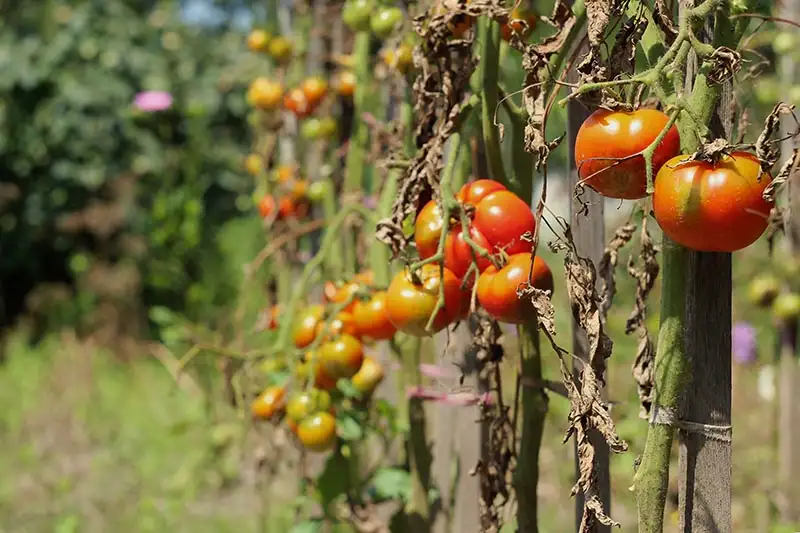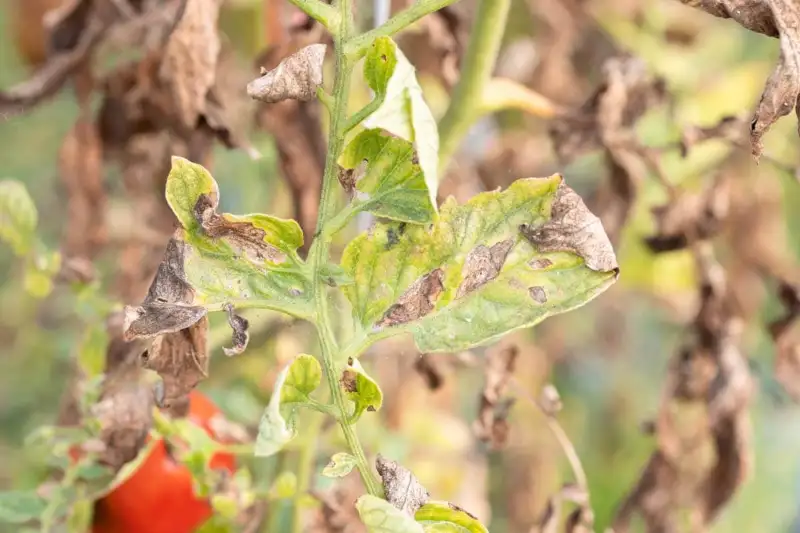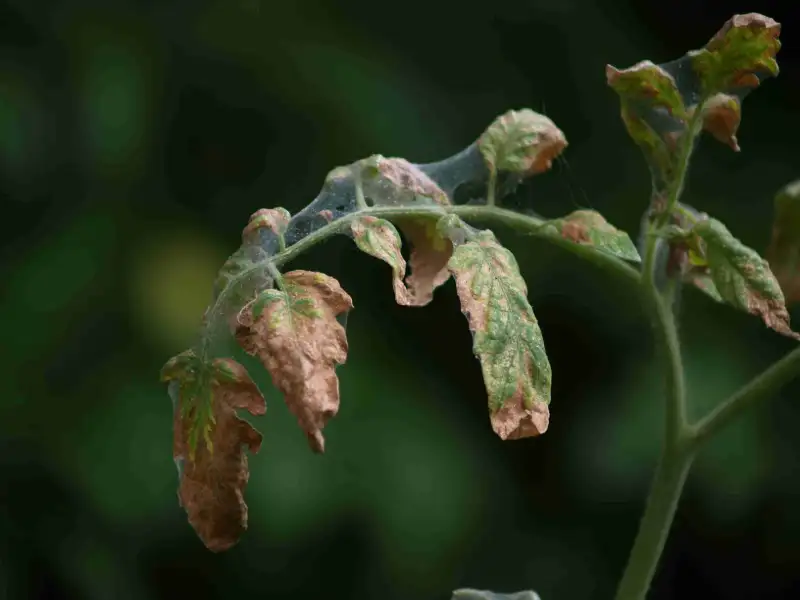Tomato plant wilting is the STUFF OF NIGHTMARES for any gardener! Watching your beloved tomato plants droop and wilt slowly can be heartbreaking. It’s like watching a sad horror movie with much worse special effects!
But DON’T DESPAIR – this article will cover what you need to know to get your wilting babies back in shape.
You are in the RIGHT PLACE. We’re here to help with expertise, advice, and solutions– like a gardener’s version of the A-Team. [**Cue the theme song]
Our team is passionate about helping you. With OUR HELP, you’ll soon have your beautiful tomatoes flourishing once again!
You will know how to handle tomato plants LIKE A PRO. So you won’t have to worry about turning into an onion-only gardener. Onions, too, bring tears, you know!
We’ll discuss things to do with wilting tomato plants. This will include reasons, causes, fixes, and preventive measures.
Grab your gardening gloves, and let’s dive in!

Reasons Why Tomato Plants Wilting

Here are the top culprits why your tomato plants wilt:
1. Wilt Virus
APHIDS and THRIPS quickly spread this nasty little virus. Both pests feed on your tomato plant leaves, like a vampire at the local bar! The tomato plants affected will start to wilt quickly, no matter how healthy they look.
2. Overwatered Tomato Plants
Too much water can cause soggy soil, leading to ROOT ROT, FUNGUS, and WILTED leaves in tomato plants. That’s one way for your tomatoes to take a swim!
3. Underwatering Tomato Plants
Giving your tomato plants too little water is also a problem. They become THIRSTY and start drooping dramatically!
4. Corrosive Soils
Certain types of soil may contain TOO MUCH SALT or other CONCENTRATED MINERALS. These can burn the delicate roots of a young tomato plant.
Your plants will start yellowing or wilting. This happens in affected sections of your tomato garden as if tiny lightning bolts had just hit them!
5. Heat Stress
High temperatures can cause tomatoes to wilt quickly. Imagine how you’d feel if you had an entire summer day in the sauna! The stress is due to temperature shock from INTENSE HEAT during hot summer days, making them sun-kissed beauties (not!). Hahaha.
6. Pest Damage
Insects such as CATERPILLARS munch away at leaves. This causes your tomatoes to go limp from lack of food energy. They reduce photosynthesis. STALK BORERS also have a similar wilting effect on your tomatoes. Think Pacman with vegetables instead of dots!
7. Not Enough Sunlight
Tomato plants need LOTS OF SUNSHINE to maintain vibrant colors and firmness. Without the light, they become depressed and droopy before you know it. They’ll look more withered than Gandalf after an intense battle with Sauron! [**Look at you smiling, nerd!]
Suggested reading: Soil PH For Tomatoes: Expert Tips To Plant
How to Identify the Causes of Wilted Tomato Plants?

So your tomato plants are wilting, and already you have some suspects in mind. But how do you identify them? You look at their mugshots, maybe? Here are some signs of the culprits :
1. Wilt Virus:
Affected plants WILT show symptoms of stunted growth, and can eventually die. It makes it seem like your tomato plants have been cursed with a bad case of the common cold!
2. Tomato spotted wilt virus (TSWV):
Tomato spotted wilt virus is a virus that affects SOLANACEOUS CROPS like tomatoes. The leaves curl up and can cause the plant to wilt and die.
It’s like a playground bully who pushes around the little guys until they give up. If you see curled-up leaves on your tomato plant, know Tomato spotted wilt virus bullied them.
3. Bacterial Wilt:
Plants infected with tomato bacterial wilt may wilt or turn YELLOW. They’ll look like they have a terrible case of Jaundice or were trapped in a sauna in the summertime. This is caused by a lack of water uptake in their roots due to bacterial infection within tomato roots.
4. Fusarium Wilt:
Tomato plants that are infected with this fungal wilt gradually wither away. They look like they’re wilting down from embarrassment! Also, you will see WILTING and YELLOWING LEAVES.
This happens to the lower leaves and comes with stunted growth. The upper leaves will remain green but slightly curled down at leaf edges or tips.
5. Southern Blight:
Southern Blight is a fungal wilt disease commonly seen on vegetables, including tomatoes. It causes foliage around the stem base to TURN BROWN/BLACK and collapse into a slimy mass.
It reminds you of that uncle who had too many beers at the family barbecue! Hahaha. The fungal infection will also rot away your tomato roots. Southern Blight also leads to sudden drying out & DEATH of the ENTIRE PLANT!
6. Root Knot Nematodes:
Root Knot Nematodes are tiny parasites that live in the soil. They are like kids hiding beneath a bed cover, waiting for someone to join them in an epic game of hide-and-seek! THESE CRITTERS ARE NOT FUN, though.
They attack plant roots and cause them to swell into knots. Does it remind you of your stomach after eating one too many cookies?! That’s where they get that creative name. The knots PREVENT nutrient/water supply leading to withered tomato plants & death.
7. Stalk Borers:
A Stalk Borer is a long narrow caterpillar that eats away inside stems. So, you won’t know till you cut open the stem & find some borers munching away. They WEAKEN the tomato plant causing wilting and eventually KILLING IT OFF! Think of an evil villain in a horror movie.
8. Verticillium Wilt:
This FUNGAL INFECTION causes the wilting of tomato plants. Your tomatoes look like they’re done with life and are waving goodbye! You will see yellowing leaves that die back from the bottom up.
The stems can appear to have DARK SPOTS OR STREAKS, making them look like they got dressed up for Halloween!
How to Fix and Treat Tomato Plants Wilting?

If your tomato plants are looking a little droopy, don’t fret! Just give them a good talking-to – like you would to any other plant feeling down. It might work! And if not, here is how you fix ’em:
1. Manage Fungal Diseases:
Look at the leaves and stems of your tomato plants for signs of fungal infections like verticillium and fusarium wilt. If you see any signs, don’t be alarmed. Remove the diseased plants and DISPOSE of them properly from your garden area.
Then, treat your babies with FUNGICIDE – much like giving medicine to a toddler. Only this time, it is for tomatoes! Get specific fungicides for FUSARIUM WILT or VERTICILLIUM WILT; they’ll thank you later!
2. Control Bacterial Wilt:
Check signs of bacterial wilt discussed earlier. If present, remove all infected plants – root and all! Think about it like you’re packing up a picnic–you don’t want to take any food that’s gone bad. So make sure to GET RID of ANYTHING touched by bacterial wilt.
Never add them to your compost pile, as it QUICKLY SPREADS the disease. Treat your tomatoes with 1% Perosan – like taking a cold pill when feeling down in the dumps! They should feel better in no time!
3. Manage Pests:
Check for any pests such as Caterpillars, Slugs, or Aphids. Remove them if you find them munching on your plants like potato chips. Then dispose of them properly away from the garden area.
Consider using natural methods such as NEEM OIL to ward off these pesky critters, so it’s bye-bye bugs! If not, you can always use insecticidal soap. It will give these intruders something more powerful than dishwashing liquid!
4. Water Wisely:
If there is no clear pest, fungal or bacterial wilt issue, water your tomatoes correctly! Container plants need MANUAL WATERING. Don’t rely on rainwater or an automated sprinkler system. This will ensure an even distribution of water throughout its pot.
Water will not pool in one area leading to ROOT ROT and wilting in tomatoes. The old saying goes: “A little bit of even watering each day keeps the wilting away!” Also, consider creating a consistent watering schedule. So they don’t get too much water at once, which can cause issues.
5. Rotate your plants:
Lastly, consider rotating your planting beds yearly, like revamping upholstery furniture. Think of it like giving your garden a makeover. Plus, it will help prevent diseases or pests from returning in future seasons.
Tips to Prevent Wilt in Tomato Plants

With tomato wilt, it’s true what they say, “An ounce of prevention is better than a pound of wilting tomatoes!” FEAR NOT! We have some simple tips to protect your precious tomatoes from plant wilt.
1. Plant-resistant varieties:
When buying new tomato plants, get ones labeled “RESISTANT” to fungal wilting diseases. Examples include plants resistant to verticillium wilt.
If you’re extra cautious with your tomato purchases, why not buy two resistant varieties? That way, you can keep one safe from any form of wilting!
2. Avoid planting near walnut trees:
WALNUT TREE ROOTS, especially black walnut trees, release a toxic material called JUGLONE. So please take it as advice that you should never mix walnut trees and tomatoes together in the same salad! It won’t even taste well. Hahaha.
This material can affect the growth of nearby tomato plants. It will result in wilting leaves or stems of young or future plants. So when growing tomatoes, keep them away from WALNUT TOXICITY! Think of the walnut tree as that TOXIC EX you want to avoid!
3. Give them just enough water:
Not too little, not too much soil – like Goldilocks said: get it just right, and your tomatoes will thrive! Goldilocks is a gardener, you know? Hahaha.
Doing this will prevent FUNGAL WILT DISEASES from infecting your plant. Because we all know how damp mushrooms love company.
4. Plant on raised beds:
Plant tomatoes on RAISED BEDS. This will help keep too much moisture away from their roots. By doing this, they prevent root rot caused by fungus or bacteria. If left unchecked, the two can lead to wilts in tomato plants over time – totally ruining the vibe!!
5. Provide well-drained soil:
Plant your tomato seedlings in WELL-DRAINING SOIL. This will prevent root rot and fungal wilt diseases such as fusarium wilt and verticillium wilt. So make sure that soil is well-drained or else you’ll have veggie nightmares!
Suggested reading: Black Spots On Tomatoes
FAQs about Tomato Plant Wilting
1. Should I cut off wilted tomato leaves?
Oh Yes. Cut off those wilted tomato leaves! Wilting is a sign of distress and can spread to other parts of the tomato plant. So, snip ’em off for a healthier harvest!
2. How do I know if my tomato plant is dying?
Is your tomato plant wilting? Are its leaves drooping and turning yellow? Say goodbye, as this could signify that your beloved plant is on its way out, as it will wilt and die.
3. Should you water tomatoes in full sun?
Yes, you should absolutely water tomatoes in full sun! They’ll happily soak up that warm summer lovin’ and reward you with sweet, juicy fruits. Just don’t forget to give ’em a generous drink once or twice a week so they can stay healthy and happy.
What’s Next
We discussed the dreaded wilting of tomato plants – from causes to prevention!
We want to keep your lush green tomatoes.
So, we told you how to identify why they’re wilting, how to fix and treat it, and tips for preventing it.
Save your crops before it’s too late!
Save your tomato plants from wilting with AsterGardening!
Get tips and tricks for your tomato plants.
Whether you are a noob or a pro, we have something for every gardener! Visit us now and say goodbye to wilted tomatoes forever!
